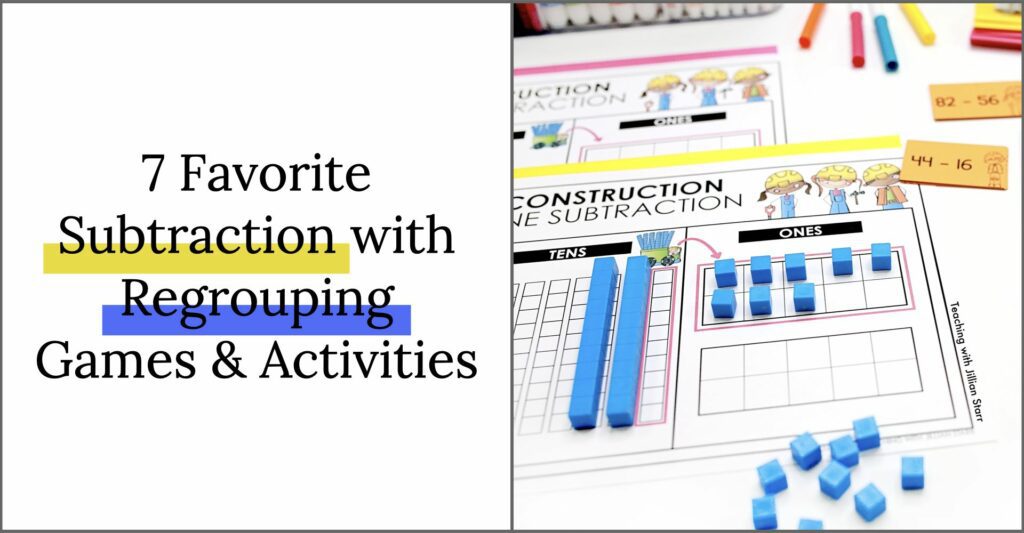
Teaching subtraction with regrouping is a marathon, not a sprint. And one that requires four things:
- The concept to be broken down into bitesize lessons
- A range of strategies to support foundational subtraction understanding
- Activities that help students visualize the process of “regrouping”
- Repeated, incrementally challenging practice
Today, I’ll share how I approach teaching 2-digit subtraction with regrouping. Then, I’ll walk you through my criteria for effective subtraction with regrouping activities. And in the process, I’ll share my favorites.
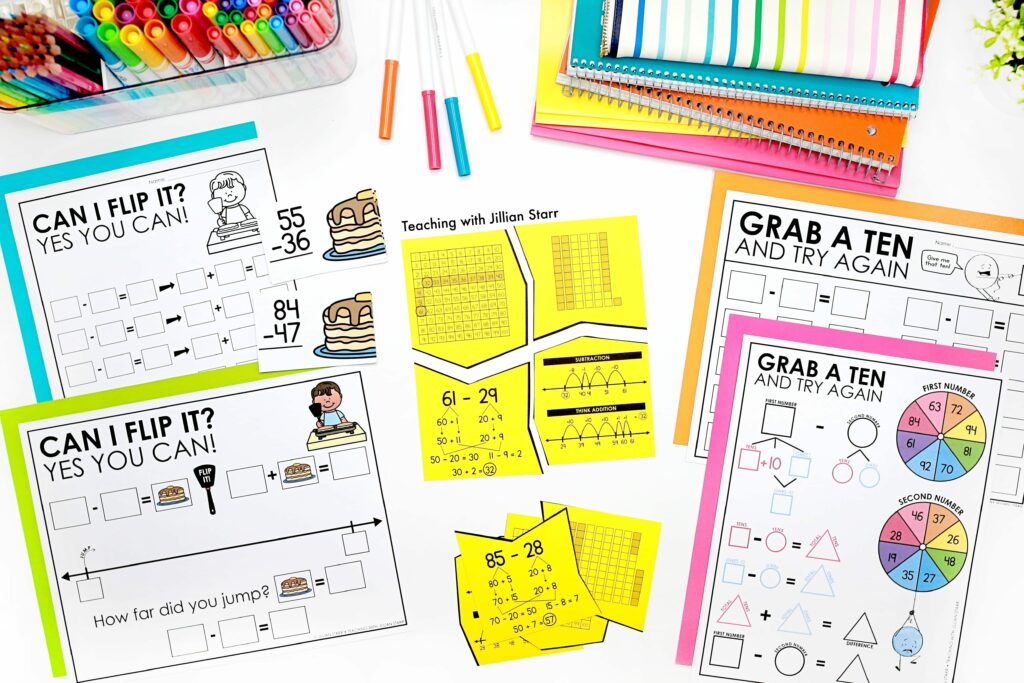
Breaking Down 2-Digit Subtraction with Regrouping
Over the years, I’ve learned that it is vital to break down subtraction with regrouping, and scaffold activities one step at a time. That way, students can build conceptual knowledge slowly and deeply. They can then apply the same pattern to more “complex” numbers.
I break down subtraction with regrouping into four progressive categories:
- Teen by 1-Digit Subtraction with Regrouping (15-7)
- Multiple of Ten by 1-Digit Subtraction with Regrouping (30-6)
- 2-Digit by 1-Digit Subtraction with Regrouping (43-5)
- 2-Digit by 2-Digit Subtraction with Regrouping (45-27)
First: Teen by 1-Digit Subtraction with Regrouping
We start here because students have previously worked hard to build fluency through twenty. We have already formed strategies with building bridges to ten (or make a ten to add). Students are familiar with crossing the first decade, so it’s a great place to build from.
When we start subtraction with regrouping from a teen number, I shift from working with ten frames to working with Unifix cubes. I want students to start creating visuals of place value, as this is going to create our entire foundation. My favorite way is to use a simple place value mat. It doesn’t have to be anything fancy. Even just a piece of paper with a line down the middle to separate tens and ones.
When working with Unifix cubes, students should create sticks of ten, place them on the left side of their paper, and then notice what they have left over. This is going to provide a visual that tells students immediately if they have enough ones, or if we are going to need to look to our tens and regroup.
For example, if we are looking at 15 – 8, I want my students to build fifteen by creating a stick of ten Unifix cubes, and then five more stacked to the right. This way, students will see that we don’t have enough ones to subtract eight, so we have to take from our tens.
In this process, we are paying close attention to place value. Probing questions I might ask include:
- How many tens did we start with?
- How many tens did we end up with?
- What happened to the ten? I only subtracted eight?
I want students to really examine what took place and begin processing the idea of regrouping as it relates to place value. I ensure students have a solid understanding of this concept before moving on to step two.

2-Digit Addition & Subtraction with Regrouping Games
Second: Multiple of Ten by 1-Digit Subtraction with Regrouping
It’s time to kick things up a notch. Again, we’re going to focus on a familiar concept with students so that we can continue building a solid foundation of subtraction with regrouping.
In early grades, students often spend a lot of time exploring combinations of ten and subtracting one-digit numbers from ten. For example, 10 – 6 = 4.
This pattern is often familiar. Therefore, the concept of subtracting a one-digit number from a tens number is already formed.
Students can see how the pattern remains the same as they use larger multiples of ten. Similar to 10 – 6 = 4, 20 – 6 = 14.
I take time to explore this pattern with students with visual supports (again using Unifix cubes). When we try 10 – 6 with unifix cubes they can see that there aren’t any ones, only a ten. We break apart the ten into ones (moving it over to the right side of the page) and then subtract.
Then we try it with different multiples of ten, while still using the Unifix cubes as visuals. 20 – 6, 40 – 6, 70 – 6. When I notice that my students are developing a deep understanding for the pattern, I switch to another familiar combination of ten. Perhaps 10-7 or 10-3, and we repeat this step in subtraction with regrouping.
Third: 2-Digit by 1-Digit Subtraction with Regrouping
Again, manipulatives in math— especially with subtraction with regrouping– are crucial for building these concepts and support students as they practice holding onto multiple or larger numbers.
We’re going to continue with our manipulatives as we move into 2-digit by 1-Digit Subtraction with Regrouping. This time we’re really going to focus on the preservation of tens. This means that we are going to spend time noticing how many tens we started with, and how many we end up with after we regroup.
We are also going to begin digging into looking at a range of 2-digit by 1-digit subtraction problems and see if we can determine which problems will require regrouping before we even start! Here it’s important that we let students explore the problems and see if they can discover clues independently instead of having them directed to a strategy. This will almost always help the idea stick better!
Fourth: Two-Digit Minus Two-Digit Subtraction with Regrouping
Finally! You’ve built your students up to full-on double-digit subtraction with regrouping. By now, your students have experienced subtraction within higher decades. Additionally, they have had some experience with building their working memory to hold onto multiple groups of tens and ones.
They are READY!
Advice: Just because your students are ready for double-digit subtraction doesn’t mean you should stop doing all prerequisites. It is constructive to mix things up (interleaving). It will jog their memory and help them build a lasting understanding of subtraction patterns.
Favorite Activities for Subtraction with Regrouping
I love thinking about the nitty gritty of math and how to make it accessible to all students. But, choosing activities to support the fine-tuned process of breaking down complex, abstract concepts can be difficult. Why? Not all activities are equal.
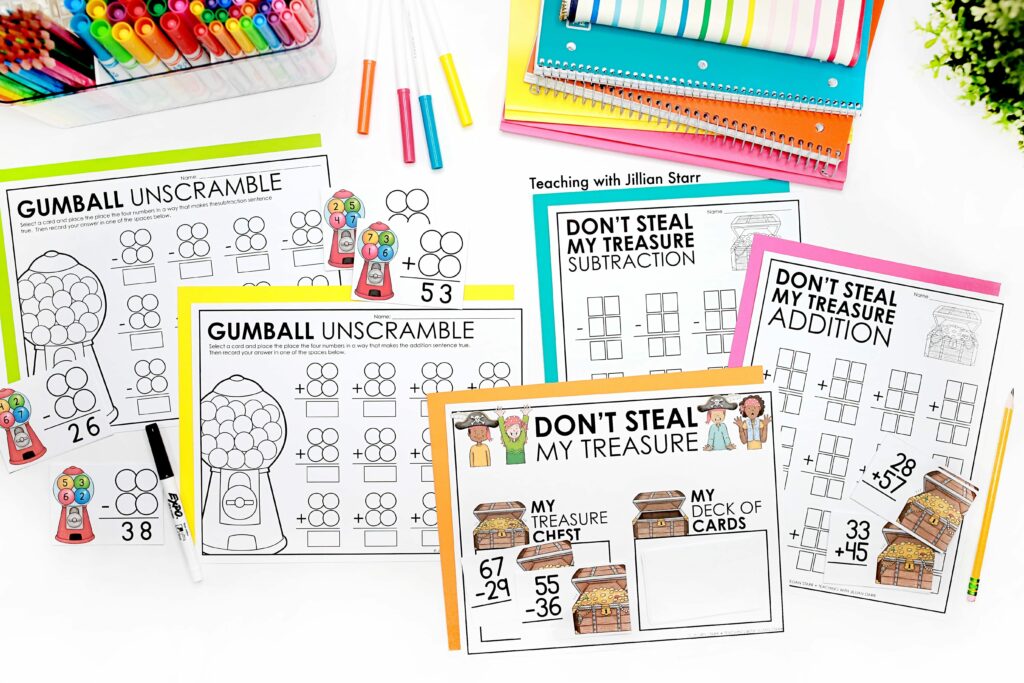

Students need structured support to learn and practice subtraction with regrouping while doing an independent activity. Yes, I begin by demonstrating and teaching subtraction with regrouping strategies in whole and small groups. However, in centers, I use small groups and need activities that students can do independently.
That’s why I make sure my subtraction with regrouping activities:
- Include Visuals
- Include Step-by-Step Modeling
- Can be easily Differentiated
- Can be Self-Supported as an independent activity




2-Digit Addition & Subtraction with Regrouping Games
Visuals
There are multiple ways to visualize a math problem. But did you know that some visualizations can actually help students see the underlying mathematical patterns? On the flip side, other visualizations merely show the steps.
I try to find and create visuals that show the patterns. And, ideally (because every brain is different), in more than one way.
2-Digit Subtraction Jigsaw Puzzles
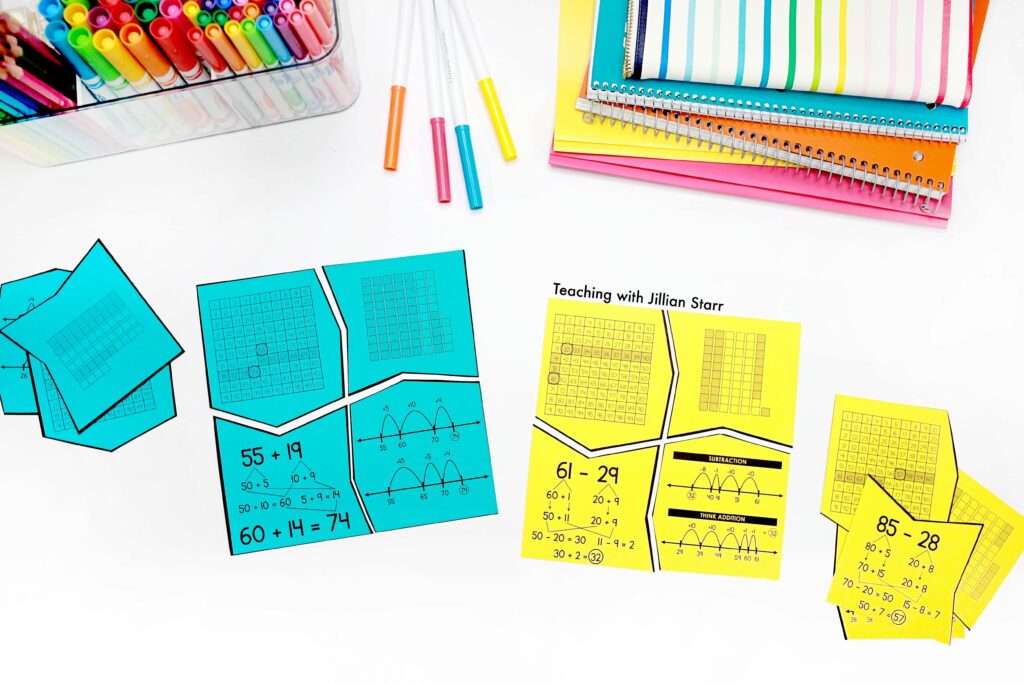

My 2-Digit Subtraction Jigsaw Puzzles are a favorite for visuals. Each puzzle contains four representations of the same math problem:
- On a hundred-chart/99-chart
- A visual of base ten blocks
- Breaking down numbers into place values
- On a number line
Here’s how to play:
- Cut each puzzle into four pieces by cutting along the black edge.
- Present each student with multiple puzzles, mixed up and ready for them to solve.
- Each puzzle (connecting all representations) makes a square.
- Students find all the puzzle pieces that represent the same subtraction problem.
- They arrange the puzzle pieces back into a square.
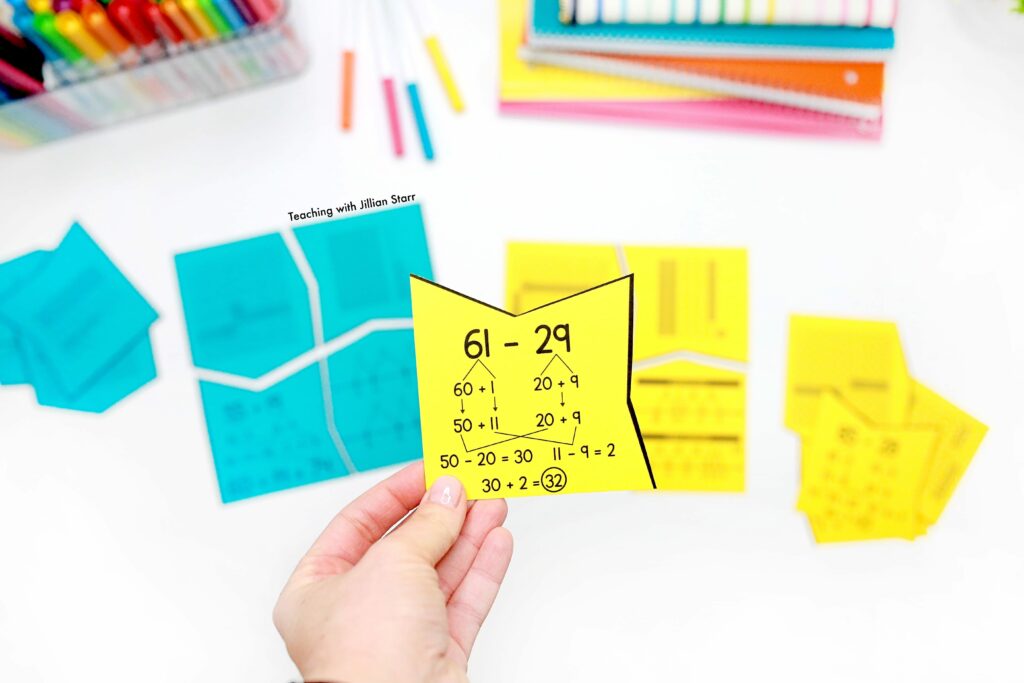

Flexibility/Modifications:
2-Digit Subtraction Jigsaw Puzzles are a great way to get kids to use their gross motor muscles and math-solving and reasoning skills. In partnerships or independently, students can spread out the puzzles on the floor, take up space, and try to solve them all.
Activities That Model the Steps
If I could work one-on-one with every child simultaneously, I would. However, we all know that’s just not possible! Students need to go to independent practice before they are fully independent. That’s why I try to find activities that guide and model the steps of subtraction with regrouping.
Deconstruction Zone
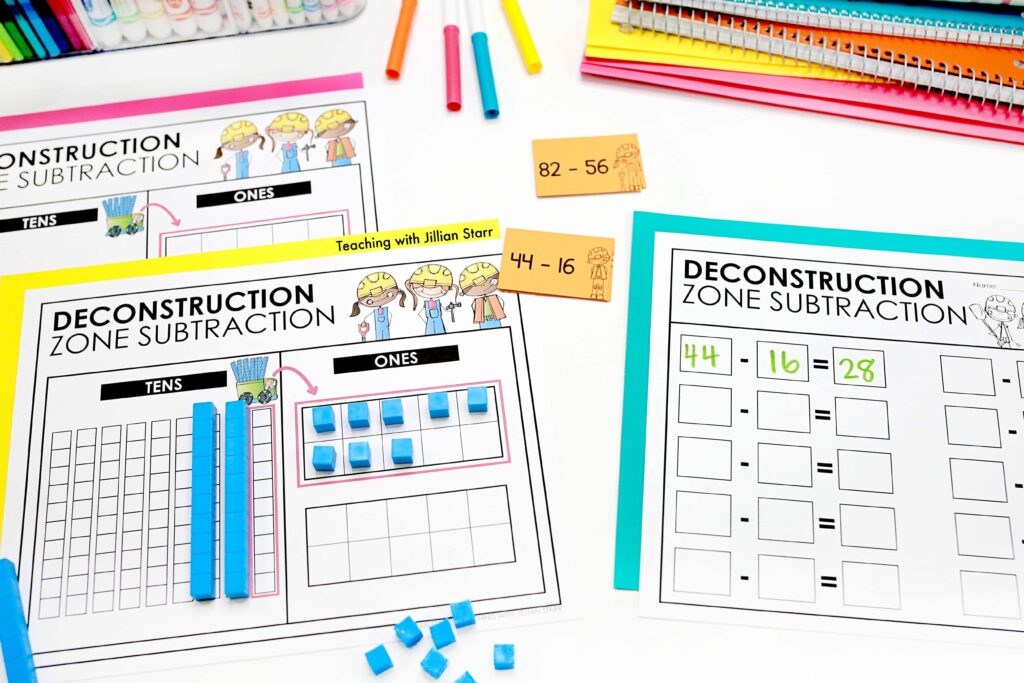

Deconstruction Zone is one of my absolute favorites. First, this is an excellent activity to slowly build up to double-digit subtraction with regrouping (yay, differentiation). There are three versions!
Students need four materials:
- A building board
- A set of construction zone cards (these differentiate)
- A set of base ten blocks
- A recording sheet


Here’s how to play:
- Set up one building board with a matching set of cards (Pick a set from any of the four stages of teaching from above). All cards should be face-down in a pile.
- Flip over one card to receive a subtraction problem.
- Build the first number (the minuend) with base ten blocks. Place the tens on the left side and those on the right inside the tens frame.
- Next, remove the subtrahend (the number being subtracted) from your base ten blocks.
- If you don’t have enough ones, “break” or decompose a ten rod into ten ones and place those in the ten-frame on the right.
- After, count the total base-ten blocks you have (by tens and ones). That’s your difference!
- Record your final answer!
As you may have noticed, Deconstruction Zone playfully walks students through the PHYSICAL process of decomposition. That translated into the act of “regrouping” in the abstract.
Can I Flip It? Yes, You Can!
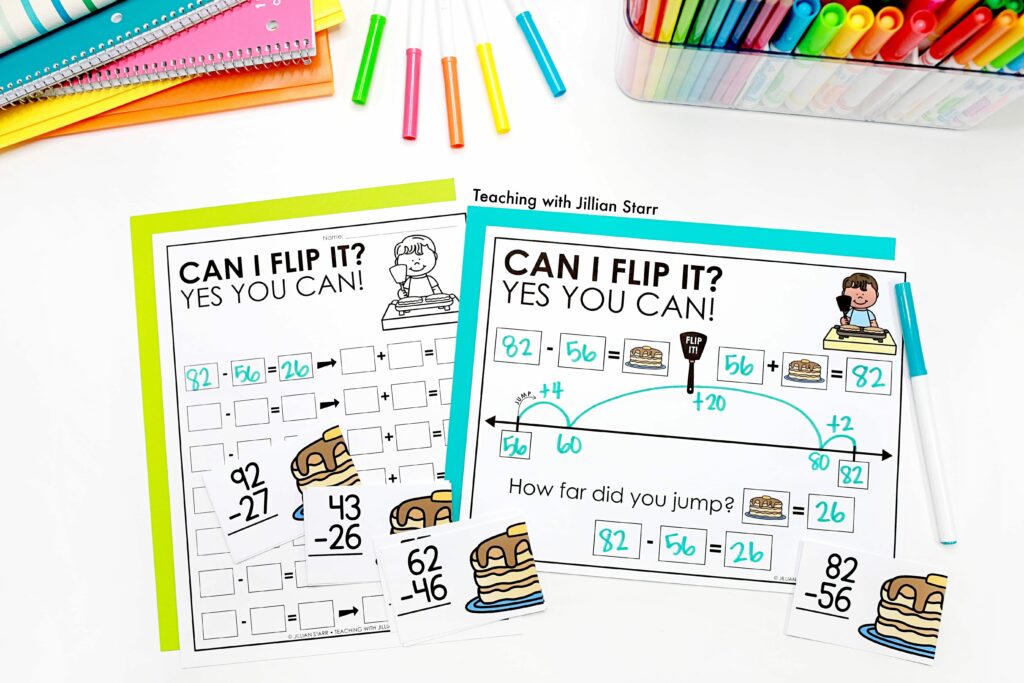

Can I Flip It? (Yes, You Can!) is a fantastic way to get kids to think critically about subtraction problems by modeling them on a number line. Students will walk away with a better understanding of the relationship between addition and subtraction and can do so with independence through the visual aid.
Sometimes, students forget that strategies, such as using a number line, can be used for problems no matter the number of digits. Even if it is a subtraction problem that involves regrouping, foundational patterns and strategies still apply!
Students will receive the following:
- A deck of cards
- A recording sheet
- A laminated board
Here’s how to play:
- Students pick a playing card with a subtraction number sentence and write it on their board.
- Next, before finding the difference, they flip it into an addition problem where one of the addends is unknown, turning the minuend (the greater number) into the sum and the subtrahend into an addend.
- Then, they use the number line to “jump” from the known addend to the sum.
- Finally, they write the value of jumps in the original subtraction and addition sentences and record them on the recording sheet.
Grab a Ten and Try Again
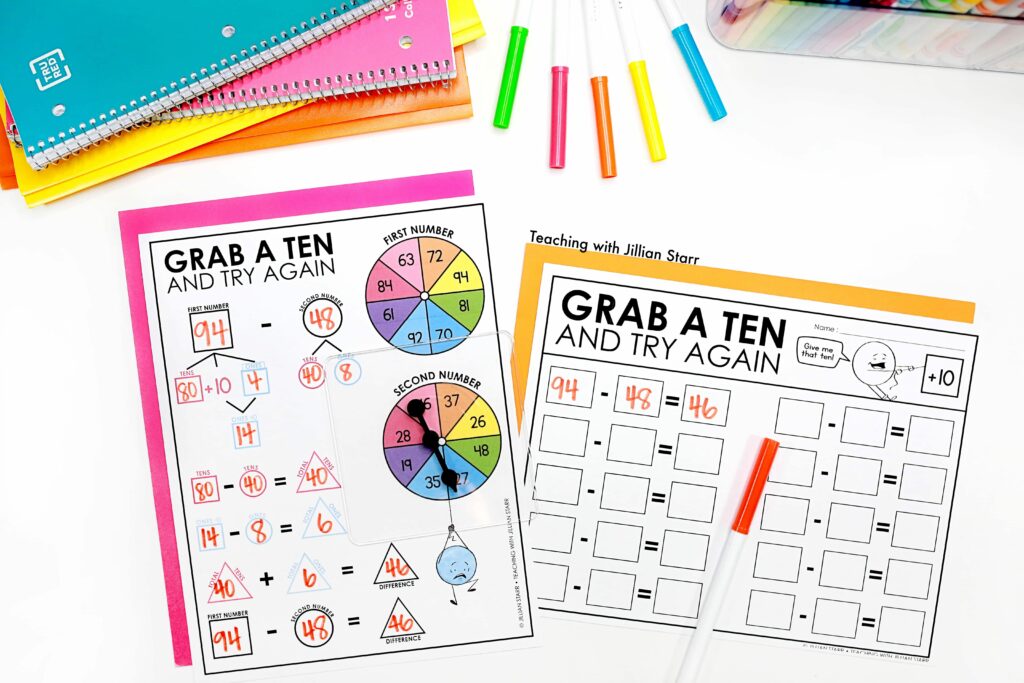

This is another great activity that supports the final stage of subtraction with regrouping skill-building. Grab a Ten and Try Again explicitly guides students through 2-digit subtraction with regrouping. In fact, the beauty of this activity is that it is the teacher.
Bonus: Grab a Ten is simple, with almost zero prep.
So, what is it? It is a graphic organizer that walks students through the process of breaking down 2-digit numbers by place value. This is crucial for students who are ready to move to the next stage, but they still need foundational support around place value and support to see the WHY behind the regrouping strategy.


Students need:
- A spinner
- A sheet protector
- A dry-erase marker
- A recording page
Students spin the spinner to find their minuend and subtrahend (their first and second numbers). Then, they follow the graphic organizer to break down the numbers into tens and ones.
Easy to Differentiate Activities
As the kid who regularly got the “easy” activities, I know firsthand the embarrassment it can cause. Now, as a teacher, I know that students learn at different paces. That’s why I always include easy-to-differentiate activities in my centers. It is more valuable to simplify or complexify the same activity than give students different activities. Likewise, it is less work for you. Win-win.
Low frustration tolerance or still working through the subtraction with regrouping progression are the two most common reasons I differentiate. For students with low frustration tolerance that can tackle more complex problems, I usually look for activities that include a mix of regrouping and non-regrouping problems. That way, before a challenging problem, they get the “reward” feeling of figuring out a few others.
How Will You Jump?
Grab your pogo stick because How Will You Jump? hits all four of the main things I look for in activities.
- It includes visuals.
- It models a process for subtraction (subtraction on a number line).
- It can be differentiated.
- It can be played independently (and in small groups).




2-Digit Addition & Subtraction with Regrouping Games
Here’s how you play:
- You begin with a board, playing cards, and a pencil (or dry-erase marker if your board is laminated)
- Pick a card with a subtraction expression
- Decide: will you start with the minuend and jump backward or the subtrahend and jump forward?
- If you start with your minuend, you’ll jump backward the amount of your subtrahend. You choose the number of jumps that feels best (jumps of 1, 2, 5, 10, 20, etc.). Eventually, you’ll land on the total (the difference).
- Then, you’ll write your completed number sentence on the recording page.
Self-Supporting Tasks
It might go without saying, but I’ll say it anyway: I’m always looking for self-supporting tasks or tasks that a partner can check. After all, I can’t be everywhere at once. And ultimately, I want students to do all their work independently. The goal is to give them independence in my classroom and beyond.
But here’s the catch: I don’t just want students to work silently and get work done independently. I want them to be able to check their own answers or a peer’s answers without my support. Ideally, this happens through the process of the activity. Not just as a checkpoint at the end.
Gumball Unscramble
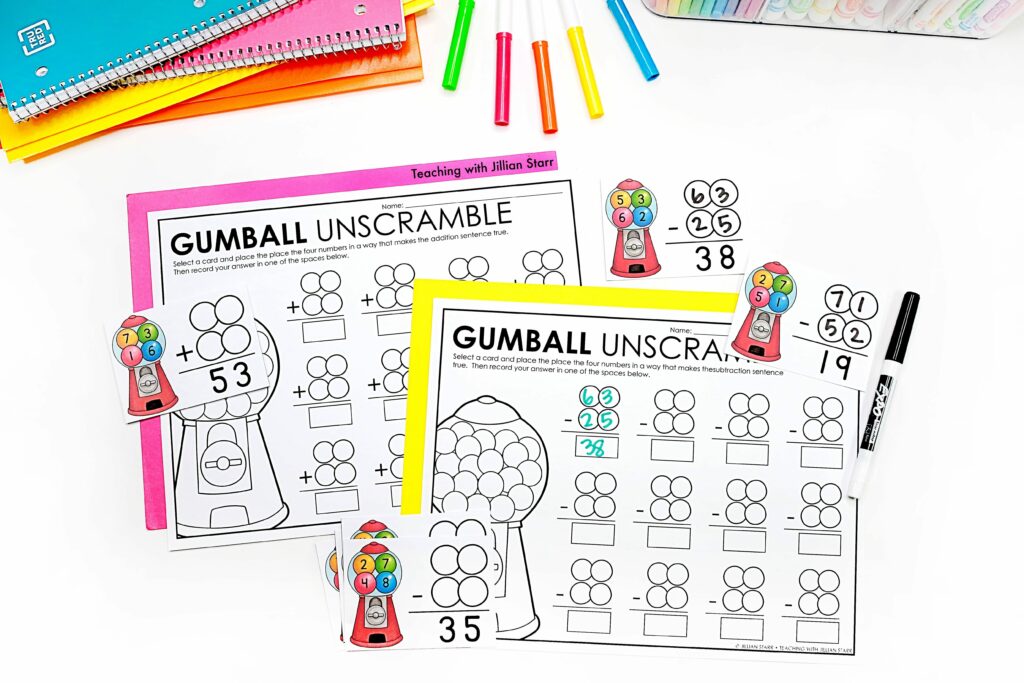

One of my favorite self-supporting tasks is Gumball Unscramble. It can be completed independently and incorporates a natural self-checking process.
Here’s how you play:
- Start with gumball puzzle cards (ideally laminated), a recording page, and a pencil (or dry-erase marker)
- Examine the four digits in the gumball container.
- Use the four digits to create a TRUE number sentence that equals the corresponding difference at the bottom.
- Record the numbers in the circles above the difference
Teacher Tip: It is helpful to laminate the puzzle cards. Then, students can use dry-erase markers to solve the problems. After, they can transfer their answers onto a recording sheet.
Don’t Steal My Treasure!


Partner stations are also a great way to build up independence with subtraction with regrouping. Often, students are still learning how to check their work. It requires a lot of awareness and mastery of subtraction with regrouping skills.
While many activities work well in partners, I regularly return to Don’t Steal My Treasure!
Don’t Steal My Treasure is best played in small group lessons or partner stations.
Players start with the following:
- A deck of Don’t Steal My Treasure cards
- A board
- A recording sheet
- A pen or pencil
Here’s how to play:
- Players deal out the cards and place them face down on their board.
- Simultaneously, each player flips over the top card on the pile.
- Each player must determine whether their problem needs to use regrouping
- If one player has a subtraction with regrouping problem, and the other does not, they can STEAL their opponent’s card. But, to do so, they must accurately solve their subtraction with regrouping problem.
- Peer Checking Alert: To officially steal their opponent’s card, they must solve the problem correctly. That means their partner needs to check the answer.
- They continue to take turns collecting (and stealing) each other’s problems, placing them in their treasure chests.
- The game finishes when one player runs out of cards, and the player with all the cards in their treasure chest wins!
Note: This is a fantastic opportunity for students to check each other’s work. And trust me, they will be motivated to do so by the idea of winning. However, students need to learn and practice how to check a partner’s work appropriately and win gracefully (SEL meets math!).
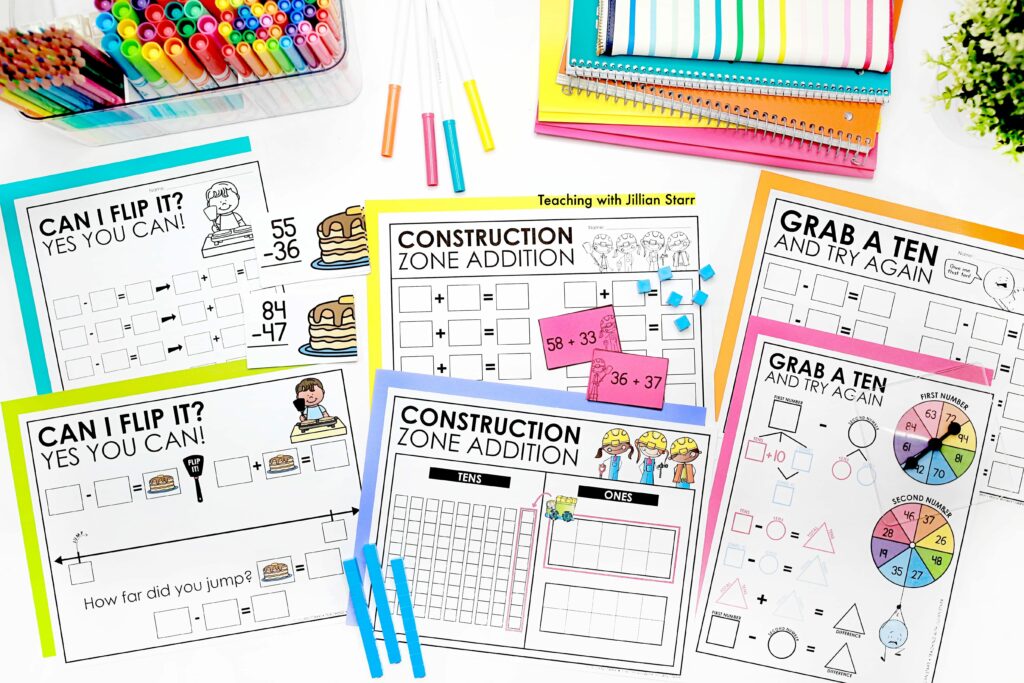

I hope this post helps as you approach this big step in your young mathematicians’ journeys. Breaking down complex concepts can feel tedious at times. However, if you go slow now, you’ll go much further later. There will be fewer roadblocks later in the year. Swear by another subtraction with regroup activity? Please let me know! I love hearing your ideas.

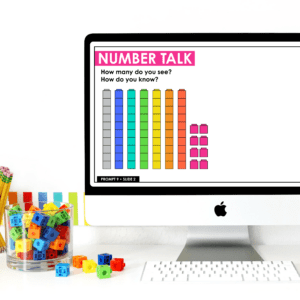
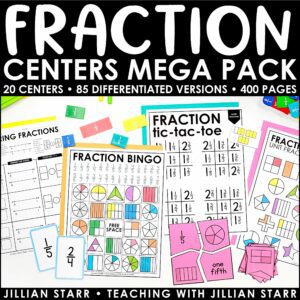
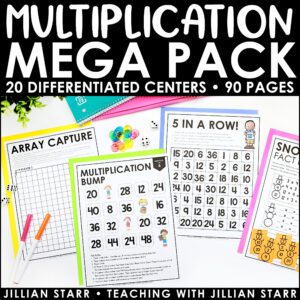
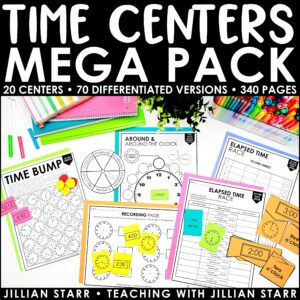
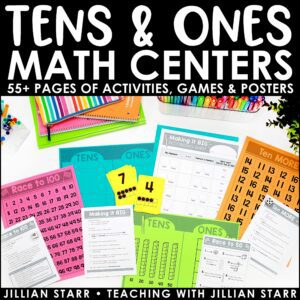
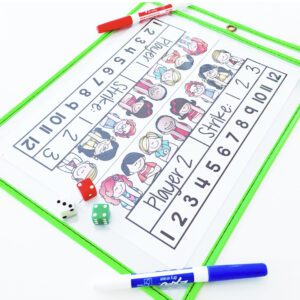

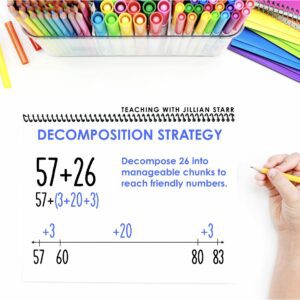


Leave a Comment